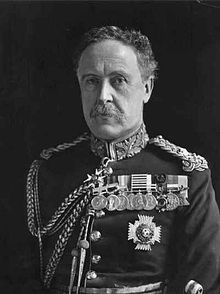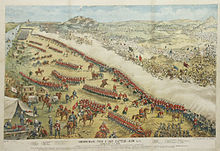Sir Neville Lyttelton | |
|---|---|
 General The Honourable Sir Neville Lyttelton | |
| Born | 28 October 1845 Hagley, Worcestershire |
| Died | 6 July 1931 (aged 85) Royal Hospital Chelsea, London |
| Spouse(s) | Mary Glynn |
| Military career | |
| Allegiance | |
| Service | British Army |
| Years of service | 1865–1912 |
| Rank | General |
| Commands | Commander-in-Chief, Ireland Chief of the General Staff Commander-in-Chief, South Africa 4th Division 2nd Division 4th Brigade 2nd Brigade 2nd Battalion Rifle Brigade 1st Battalion Rifle Brigade |
| Battles / wars | Fenian Raids Anglo-Egyptian War Mahdist War Second Boer War |
| Awards | Knight Grand Cross of the Order of the Bath Knight Grand Cross of the Royal Victorian Order Mentioned in Despatches Order of Osmanieh (Ottoman Empire) |
General Sir Neville Gerald Lyttelton, GCB, GCVO, PC (Ire) (28 October 1845 – 6 July 1931) was a British Army officer from the Lyttelton family who served against the Fenian Raids, and in the Anglo-Egyptian War, the Mahdist War and the Second Boer War. He was Chief of the General Staff at the time of the Haldane Reforms and then became Commander-in-Chief, Ireland.
Military career
[edit]Born the son of 4th Baron Lyttelton and Mary Lyttelton (née Glynne) and educated at Eton College, Lyttelton was commissioned into the Rifle Brigade in January 1865.[1] As a junior officer he was sent to Canada, where he helped defeat the Fenian raids in 1866 and served as secretary to the Oregon Boundary Commission in 1867.[1] He was promoted to lieutenant on 14 July 1869,[2] to captain on 13 October 1877[3] and to major on 22 February 1882.[4] In 1880 he was made private secretary to Hugh Childers, Secretary of State for War.[1]
Lyttelton took part in the Anglo-Egyptian War in 1882 as an Aide-de-Camp to Sir John Adye, from 1 August 1882.[5] He saw action at the Battle of Tel el-Kebir and was mentioned in despatches.[6] He was promoted to brevet lieutenant colonel[7] and awarded the Order of Osmanieh (4th Class) on 17 November 1882.[8]
Lyttelton became assistant military secretary to Lieutenant General Sir John Adye in his role as Governor of Gibraltar on 1 January 1883[9] and military secretary to Lord Reay, Governor of Bombay in 1885.[1] In his young life he made friends, mixing in whiggish aristocratic circles with Edward Grey and Arthur Balfour, later the shapers of imperial foreign policy.[10] He was promoted to brevet colonel on 18 November 1886[11] and became second-in-command of the 3rd Battalion of his regiment in 1890.[1] Promoted to the substantive rank of lieutenant colonel on 9 November 1892,[12] he became commanding officer of the 1st Battalion of his regiment in 1893 and went on to be commanding officer of the 2nd Battalion of his regiment in Ireland.[1]

He went on to be assistant adjutant-general at Headquarters in December 1894 and assistant military secretary there in October 1897[1] and took part in the state funeral of Former prime minister William Gladstone in May 1898.[13]
Lyttelton was given command of 2nd Brigade with the temporary rank of brigadier general on 13 July 1898[14] and led his brigade at the battle of Omdurman in September 1898 during the Mahdist War.[1]
Lyttelton returned to his role as assistant military secretary at headquarters on 21 October 1898[15] and then, having become a supernumerary major general for distinguished service in the field on 15 November 1898[16] and promoted to the substantive rank of major general on 10 February 1899,[17] he briefly took back his old command at 2nd Brigade, now based at Aldershot Command, on 1 September 1899.[18]
Lyttelton served in the Second Boer War as commander of the 4th Brigade in South Africa from 9 October 1899.[19] He temporarily became general officer commanding the 2nd Division in February 1900,[20][21] then commanded the 4th Division,[22] and was involved in the Battle of Spion Kop in January 1900 and the Battle of Vaal Krantz in February 1900, leading to the Relief of Ladysmith later that month.[1] Promoted to lieutenant general for distinguished service in the field on 22 March 1900,[23] Lord Roberts in his despatch referred to Lyttelton as an officer "with great coolness under fire, and considerable tactical knowledge and resource...an excellent commander in the field."[24] He was in command of the troops in Natal until June 1902, when he became Commander-in-Chief of the whole of South Africa following the end of the Second Boer War the previous month.[25][26] In this role Lyttelton and his wife sought to repair relations with the Boer community.[1] In the South Africa honours list published on 26 June 1902, Lyttelton was knighted as a Knight Commander of the Order of the Bath (KCB).[27]

On 12 February 1904 Lyttelton was appointed Chief of the General Staff and a member of the newly formed Army Council.[28] This new post was created following the abolition of the post of Commander-in-Chief of the Forces as recommended by Lord Esher in the Esher Report.[1] Lyttelton was promoted to general on 9 April 1906.[29] This was the time of the Haldane Reforms which sought to implement both a new expeditionary force and a new territorial force, but according to Edward M Spiers, Lyttelton was not up to the task – he was "feckless, malleable, and failed to lead the Army Council".[1]
Lyttelton moved on to become Commander-in-Chief, Ireland on 10 May 1908.[30] He took part both in the funeral procession following the death of King Edward VII in May 1910[31] and the coronation procession for King George V in June 1911.[32] He was appointed Knight Grand Cross of the Royal Victorian Order on 12 July 1911[33] and retired on 10 August 1912.[34]
In retirement Lyttelton was a member of the Mesopotamia Commission which sat in 1916/17.[35]
The King insisted on his appointment as Governor of the Royal Hospital Chelsea from 10 August 1912[36] until his death there on 6 July 1931.[1]

Family
[edit]In 1883 Lyttelton married Katharine Sarah Stuart-Wortley, the youngest of the nine children of the politician James Stuart-Wortley and Jane Lawley. They had three daughters:[37]
- Lucy Blanche Lyttleton (1884–1977), who married the politician Charles Masterman and had three children, including Margaret
- Hilda Margaret Lyttleton (1886–1972), who married Arthur Morton Grenfell and had four children, including Mary (mother of William Waldegrave), Frances and Laura (the wife of Lord Ballantrae)
- Mary Hermione Lyttleton (1894–), who married the businessman Lionel Hichens and had six children, including Stella (wife of Richard Hornby) and Andrew[38]
References
[edit]- ^ a b c d e f g h i j k l m "Neville Lyttelton". Oxford Dictionary of National Biography (online ed.). Oxford University Press. 2004. doi:10.1093/ref:odnb/34657. Retrieved 18 February 2012. (Subscription or UK public library membership required.)
- ^ "No. 23516". The London Gazette. 13 July 1869. p. 3957.
- ^ "No. 24517". The London Gazette. 30 October 1877. p. 5923.
- ^ "No. 25085". The London Gazette. 17 March 1882. p. 1214.
- ^ "No. 25134". The London Gazette. 1 August 1882. p. 3580.
- ^ "No. 25162". The London Gazette. 2 November 1882. p. 4879.
- ^ "No. 25169". The London Gazette. 17 November 1882. p. 5174.
- ^ "No. 25169". The London Gazette. 17 November 1882. p. 5168.
- ^ "No. 25175". The London Gazette. 8 December 1882. p. 6250.
- ^ D.Owen, "The Military Perspective", p. 35
- ^ "No. 25645". The London Gazette. 16 November 1886. p. 5530.
- ^ "No. 26343". The London Gazette. 8 November 1892. p. 6238.
- ^ "No. 26980". The London Gazette. 22 June 1898. p. 3845.
- ^ "No. 26988". The London Gazette. 19 July 1898. p. 4355.
- ^ "No. 27015". The London Gazette. 18 October 1898. p. 6056.
- ^ "No. 27023". The London Gazette. 15 November 1898. p. 6689.
- ^ "No. 27064". The London Gazette. 21 March 1899. p. 1906.
- ^ "No. 27113". The London Gazette. 1 September 1899. p. 5443.
- ^ "No. 27126". The London Gazette. 13 October 1899. p. 6180.
- ^ "The War – Natal". The Times. No. 36067. London. 16 February 1900. p. 5.
- ^ "No. 27282". The London Gazette. 8 February 1901. p. 937.
- ^ "No. 27282". The London Gazette. 8 February 1901. p. 962.
- ^ "No. 27306". The London Gazette. 19 April 1901. p. 2703.
- ^ "No. 27282". The London Gazette. 8 February 1901. p. 976.
- ^ "Latest intelligence – The South African command". The Times. No. 36792. London. 12 June 1902. p. 7.
- ^ "No. 27496". The London Gazette. 18 November 1902. p. 7339.
- ^ "No. 27448". The London Gazette (Supplement). 26 June 1902. p. 4191.
- ^ "No. 27645". The London Gazette. 12 February 1904. p. 939.
- ^ "No. 27907". The London Gazette. 24 April 1906. p. 2798.
- ^ "No. 28137". The London Gazette. 15 May 1908. p. 3578.
- ^ "No. 28401". The London Gazette (Supplement). 26 July 1910. p. 5481.
- ^ "No. 28535". The London Gazette (Supplement). 26 September 1911. p. 7095.
- ^ "No. 28513". The London Gazette. 14 July 1911. p. 5265.
- ^ "No. 28634". The London Gazette. 9 August 1912. p. 5921.
- ^ "'Appendix 1', Office-Holders in Modern Britain: Volume 10: Officials of Royal Commissions of Inquiry 1870–1939 (1995), pp. 85–8". British History Online. Retrieved 12 February 2012.
- ^ "No. 28634". The London Gazette. 9 August 1912. p. 5919.
- ^ Mosley, Charles, editor. Burke's Peerage, Baronetage & Knightage, 107th edition, 3 volumes. Wilmington, Delaware, U.S.A.: Burke's Peerage (Genealogical Books) Ltd, 2003.
- ^ "Hichens, John". Winchester College. Retrieved 24 June 2019.
Bibliography
[edit]- Gen Sir Neville Lyttelton, Eighty Years: Soldiering, Politics, Games, London: Hodder & Stoughton, 1927.
- Spiers, Edward M. (1984). Haldane: Army Reformer. Edinburgh University Press. ISBN 978-0-85224-370-1.
